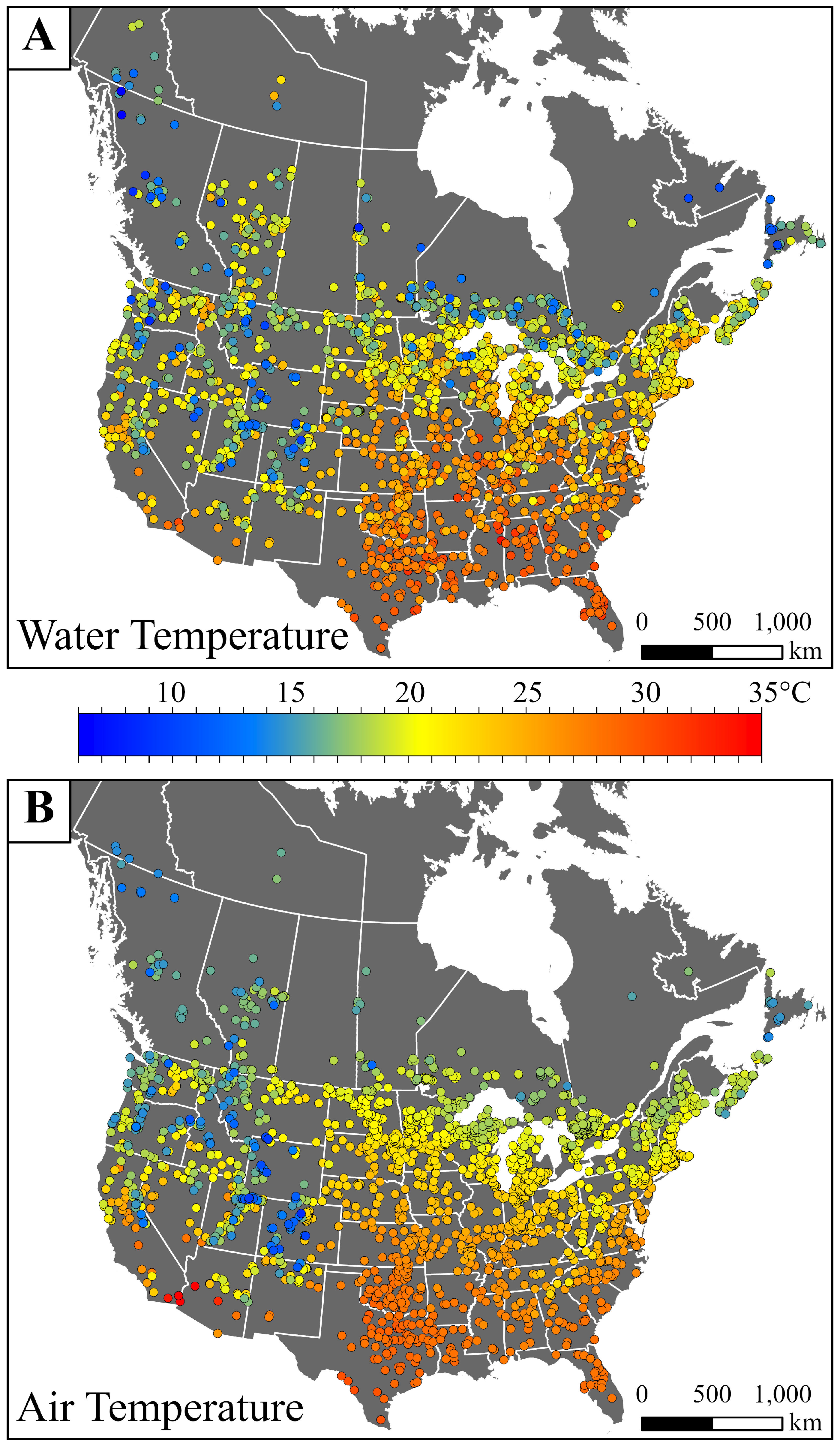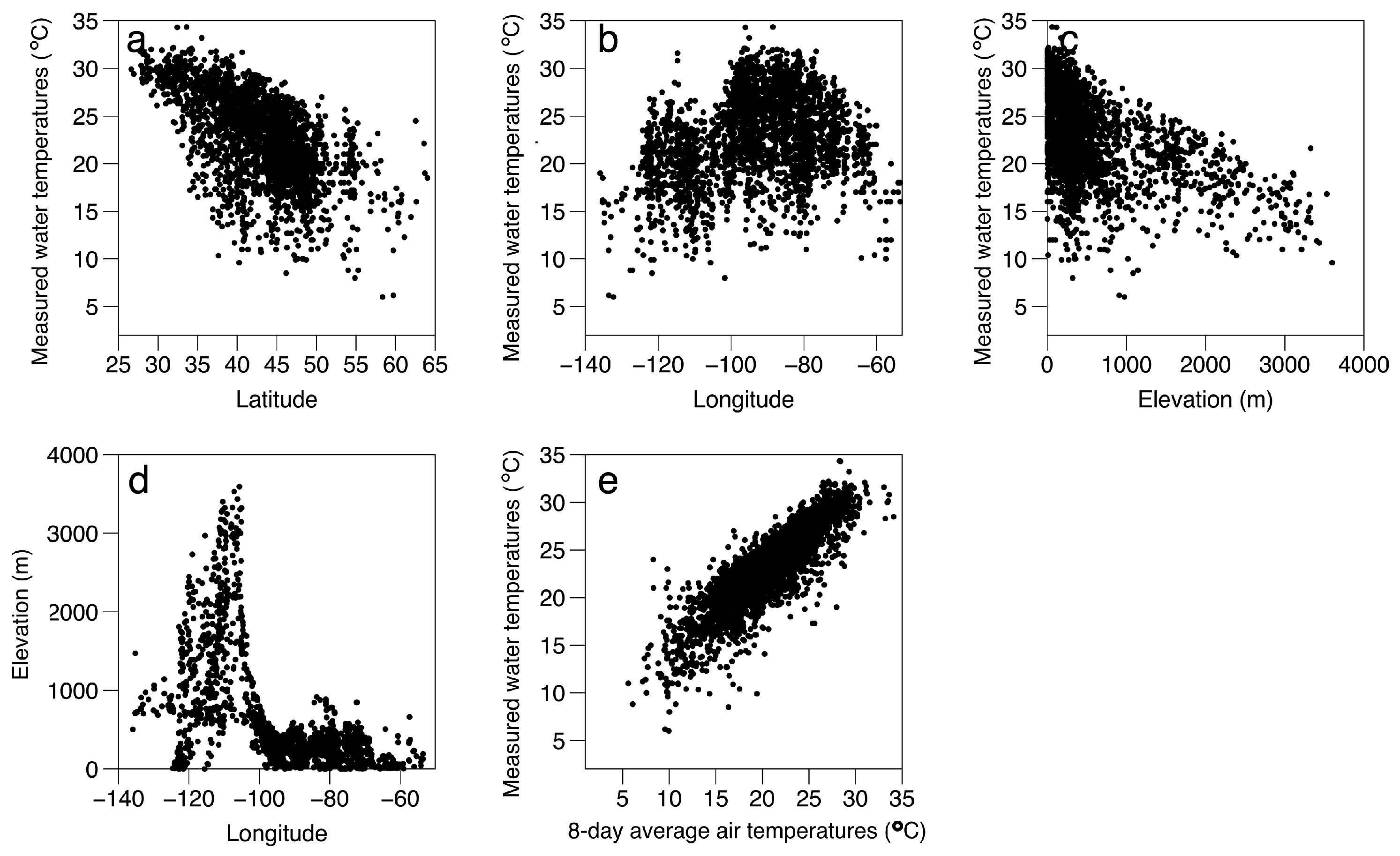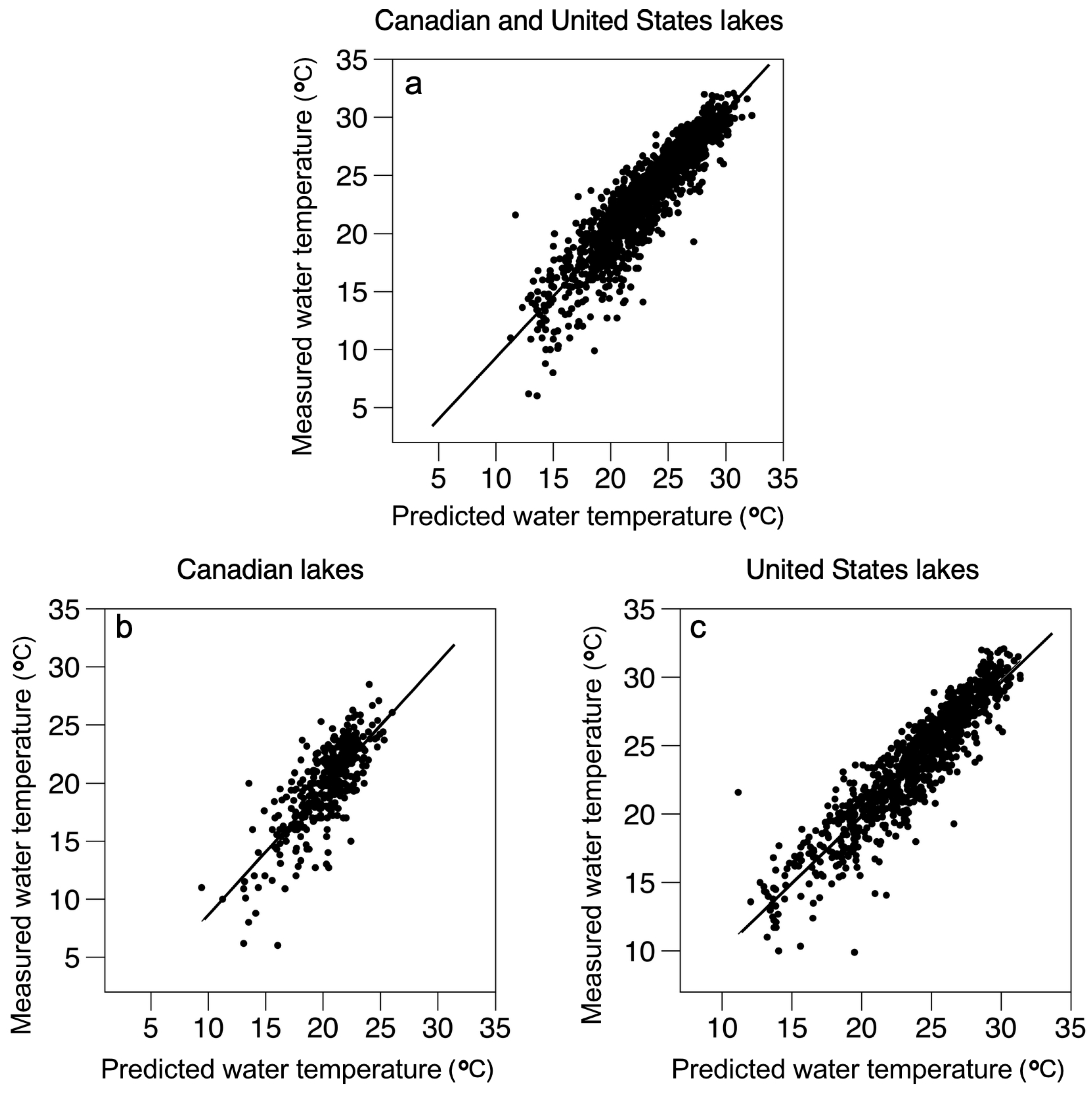The Distribution and Prediction of Summer Near-Surface Water Temperatures in Lakes of the Coterminous United States and Southern Canada
Abstract
:1. Introduction
2. Materials and Methods
2.1. United States Lakes
2.2. Canadian Lakes
2.3. Data Analyses
3. Results
4. Discussion
Supplementary Materials
Author Contributions
Funding
Acknowledgments
Conflicts of Interest
References
- Kraemer, B.M.; Anneville, O.; Chandra, S.; Dix, M.; Kuusisto, E.; Livingstone, D.M.; Rimmer, A.; Schladow, S.G.; Silow, E.; Sitoki, L.M.; et al. Morphometry and average temperature affect lake stratification responses to climate change. Geophys. Res. Lett. 2015, 42, 4981–4988. [Google Scholar] [CrossRef] [Green Version]
- Brookes, J.D.; Carey, C.C. Resilience to blooms. Science 2011, 334, 46–47. [Google Scholar] [CrossRef] [PubMed]
- Rigosi, A.; Hanson, P.; Hamilton, D.P.; Hipsey, M.; Rusak, J.A.; Bois, J.; Sparber, K.; Chorus, I.; Watkinson, A.J.; Qin, B.; et al. Determining the probability of cyanobacterial blooms: The application of Bayesian networks in multiple lake systems. Ecol. Appl. 2015, 25, 186–199. [Google Scholar] [CrossRef] [PubMed]
- Jackson, D.A.; Peres-Neto, P.R.; Olden, J.D. What controls who is where in freshwater fish communities—The roles of biotic, abiotic, and spatial factors. Can. J. Fish. Aquat. Sci. 2001, 58, 157–170. [Google Scholar]
- Schneider, P.; Hook, S.J. Space observations of inland water bodies show rapid surface warming since 1985. Geophys. Res. Lett. 2010, 37, 22. [Google Scholar] [CrossRef]
- O’Reilly, C.M.; Sharma, S.; Gray, D.K.; Hampton, S.E.; Read, J.S.; Rowley, R.J.; Schneider, P.; Lenters, J.D.; McIntyre, P.B.; Kraemer, B.M.; et al. Rapid and highly variable warming of lake surface waters around the globe. Geophys. Res. Lett. 2015, 42, 10–773. [Google Scholar]
- Richardson, D.C.; Melles, S.J.; Pilla, R.M.; Hetherington, A.L.; Knoll, L.; Williamson, C.E.; Kraemer, B.M.; Jackson, J.R.; Long, E.C.; Moore, K.; et al. Transparency, geomorphology, and mixing regime explain variability in trends in lake temperature and stratification across northeastern North America (1975–2012). Water 2017, 9, 442. [Google Scholar] [CrossRef]
- Woolway, R.I.; Jones, I.D.; Maberly, S.C.; French, J.R.; Livingstone, D.M.; Monteith, D.T.; Simpson, G.L.; Thackeray, S.J.; Andersen, M.R.; Battarbee, R.W.; et al. Diel surface temperature range scales with lake size. PLoS ONE 2016, 11, e0152466. [Google Scholar] [CrossRef]
- Sharma, S.; Jackson, D.A.; Minns, C.K.; Shuter, B.J. Will northern fish populations be in hot water because of climate change? Glob. Chang. Biol. 2007, 13, 2052–2064. [Google Scholar] [CrossRef]
- Alofs, K.M.; Jackson, D.A.; Lester, N.P. Ontario freshwater fishes demonstrate differing range-boundary shifts in a warming climate. Divers. Distrib. 2014, 20, 123–136. [Google Scholar] [CrossRef]
- Vander Zanden, J.M.; Casselman, J.M.; Rasmussen, J.B. Stable isotope evidence for the food web consequences of species invasions in lakes. Nature 1999, 401, 464–467. [Google Scholar] [CrossRef]
- Hansen, G.J.A.; Read, J.S.; Hansen, J.F.; Winslow, L.A. Projected shifts in fish species dominance in Wisconsin lakes under climate change. Glob. Chang. Biol. 2016, 23, 1463–1476. [Google Scholar] [CrossRef] [PubMed]
- Van Zuiden, T.M.; Chen, M.; Stefanoff, S.; Lopez, L.; Sharma, S. Projected impacts of climate change on three freshwater fishes and potential novel competitive interactions. Divers. Distrib. 2016, 22, 603–614. [Google Scholar] [CrossRef] [Green Version]
- Edinger, J.E.; Duttweiler, D.W.; Geyer, J.C. The response of water temperatures to meteorological conditions. Water Resour. Res. 1968, 4, 1137–1143. [Google Scholar] [CrossRef]
- Kettle, H.; Thompson, R.; Anderson, N.J.; Livingstone, D.M. Empirical modeling of summer lake surface temperatures in southwest Greenland. Limnol. Oceanogr. 2004, 49, 271–282. [Google Scholar] [CrossRef]
- Piccolroaz, S.; Healey, N.C.; Lenters, J.D.; Schladow, S.G.; Hook, S.J.; Sahoo, G.B.; Toffolon, M. On the predictability of lake surface temperature using air temperature in a changing climate: A case study for Lake Tahoe (USA). Limnol. Oceanogr. 2018, 63, 243–261. [Google Scholar] [CrossRef]
- Hondzo, M.; Stefan, H.G. Lake water temperature simulation model. J. Hydraul. Eng. 1993, 119, 1251–1273. [Google Scholar] [CrossRef]
- Shuter, B.J.; Schlesinger, D.A.; Zimmerman, A.P. Empirical predictors of annual surface water temperature cycles in North American lakes. Can. J. Fish. Aquat. Sci. 1983, 40, 1838–1845. [Google Scholar] [CrossRef]
- Livingstone, D.M.; Lotter, A.F. The relationship between air and water temperatures in lakes of the Swiss Plateau: A case study with paleolimnological implications. J. Paleolimnol. 1998, 19, 191–198. [Google Scholar] [CrossRef]
- Sharma, S.; Walker, S.C.; Jackson, D.A. Empirical modelling of lake water-temperature relationships: A comparison of approaches. Freshw. Biol. 2008, 53, 897–911. [Google Scholar] [CrossRef]
- Schmid, M.; Hunziker, S.; Wüest, A. Lake surface temperatures in a changing climate: A global sensitivity analysis. Clim. Chang. 2014, 124, 301–315. [Google Scholar] [CrossRef]
- Rose, K.C.; Winslow, L.A.; Read, J.S.; Hanson, G.J.A. Climate-induced warming of lakes can be either amplified or suppressed by trends in water clarity. Limnol. Oceanogr. Lett. 2016, 1, 44–53. [Google Scholar] [CrossRef]
- Magee, M.R.; Wu, C.H. Response of water temperatures and stratification to changing climate in three lakes with different morphometry. Hydrol. Earth Syst. Sci. 2017, 21, 6253–6274. [Google Scholar] [CrossRef] [Green Version]
- Piccolroaz, S.; Toffolon, M.; Majone, B.A. A simple lumped model to convert air temperature into surface water temperature in lakes. Hydrol. Earth Syst. Sci. 2013, 17, 3323–3338. [Google Scholar] [CrossRef]
- Toffolon, M.; Piccolroaz, S.; Majone, B.; Soja, A.M.; Peeters, F.; Schmid, M.; Wüest, A. Prediction of surface temperature in lakes with different morphology using air temperature. Limnol. Oceanogr. 2014, 59, 2185–2202. [Google Scholar] [CrossRef] [Green Version]
- Piccolroaz, S.; Toffolon, M.; Majone, B. The role of stratification on lakes’ thermal response: The case of Lake Superior. Water Resour. Res. 2015, 51, 7878–7894. [Google Scholar] [CrossRef]
- Livingstone, D.M.; Dokulil, M.T. Eighty years of spatially coherent Austrian lake surface temperatures and their relationship to regional air temperature and the North Atlantic Oscillation. Limnol. Oceanogr. 2001, 46, 1220–1227. [Google Scholar] [CrossRef]
- USEPA. National Lakes Assessment 2007: A Collaborative Survey of Lakes in the United States; EPA 841-R-16-009; United States Environmental Protection Agency: Washington DC, USA, 2009.
- USEPA. National Lakes Assessment 2012: A Collaborative Survey of Lakes in the United States; EPA 841-R-16-113; United States Environmental Protection Agency: Washington DC, USA, 2016.
- Dewald, T.G. Applications of the NHD at the US Environmental Protection Agency. Water Res. Impact. 2006, 8, 5–7. [Google Scholar]
- Peck, D.V.; Olsen, A.R.; Weber, M.H.; Paulsen, S.G.; Peterson, C.; Holdsworth, S.M. Survey design and extent estimates for the National Lakes Assessment. Freshw. Sci. 2013, 32, 1231–1245. [Google Scholar] [CrossRef]
- Daly, C.; Halbleib, M.; Smith, J.I.; Gibson, W.P.; Doggett, M.K.; Taylor, G.H.; Curtis, J.; Pasteris, P.A. Physiographically-sensitive mapping of temperature and precipitation across the conterminous United States. Int. J. Climatol. 2008, 28, 2031–2064. [Google Scholar] [CrossRef]
- SAS Institute Inc. Statistical Analysis System, Cary. In JMP Statistics and Graphics Guide, Version 7; SAS Institute Inc.: Cary, NC, USA, 2007. [Google Scholar]
- Carmack, E.C.; Vagle, S.; Morrison, J.; Laval, B.E. Space-for-time proxy for climate change in deep lakes in the Canadian cordillera: Seasonality along a latitudinal climate gradient. J. Great Lakes Res. 2014, 40, 608–617. [Google Scholar] [CrossRef]
- Ptak, M.; Sojka, M.; Choiński, A.; Nowak, B. Effect of Environmental Conditions and Morphometric Parameters on Surface Water Temperature in Polish Lakes. Water 2018, 10, 580. [Google Scholar] [CrossRef]
- Winslow, L.A.; Hansen, G.J.; Read, J.S.; Notaro, M. Large-scale modeled contemporary and future water temperature estimates for 10774 Midwestern US Lakes. Sci. Data 2017, 4, 170053. [Google Scholar] [CrossRef] [PubMed]
- Woolway, R.I.; Merchant, C.J. Amplified surface temperature response of cold, deep lakes to Inter-annual air temperature variability. Sci. Rep. 2017, 7, 4130. [Google Scholar] [CrossRef] [PubMed]
- Zhong, Y.; Notaro, M.; Vavrus, S.J.; Foster, M.J. Recent accelerated warming of the Laurentian Great Lakes: Physical drivers. Limnol. Oceanogr. 2016, 61, 1762–1786. [Google Scholar] [CrossRef] [Green Version]
- Zhong, Y.; Notaro, M.; Vavrus, S.J. Spatially variable warming of the Laurentian Great Lakes: An interaction of bathymetry and climate. Clim. Dynam. 2018, 52, 5833–5848. [Google Scholar] [CrossRef]
- Matuszek, J.E.; Shuter, B.J. An empirical method for the prediction of daily water temperatures in the littoral zone of temperate lakes. Trans. Am. Fish. Soc. 1996, 125, 622–627. [Google Scholar] [CrossRef]
- McCombie, A.M. Some relations between air temperatures and the surface water temperatures of lakes. Limnol. Oceanogr. 1959, 4, 252–258. [Google Scholar] [CrossRef]
- Livingstone, D.M.; Lotter, A.F.; Walkery, I.R. The decrease in summer surface water temperature with altitude in Swiss Alpine lakes: A comparison with air temperature lapse rates. Artct. Anarct. Alp. Res. 1999, 31, 341–352. [Google Scholar] [CrossRef]
- Minns, C.K.; Shuter, B.J.; Davidson, A.; Wang, S. Factors influencing peak summer surface water temperature in Canada’s large lakes. Can. J. Fish. Aquat. Sci. 2017, 75, 1005–1018. [Google Scholar] [CrossRef]
- Yin, X. Reconstructing monthly global solar radiation from air temperature and precipitation records: A general algorithm for Canada. Ecol. Model. 2011, 334, 46–47. [Google Scholar] [CrossRef]
- Hondzo, M.; Stefan, H.G. Regional water temperature characteristics of lakes subjected to climate change. Clim. Chang. 1993, 24, 187–211. [Google Scholar] [CrossRef]
- Robertson, D.M.; Ragotzkie, R.A. Changes in the thermal structure of moderate to large sized lakes in response to changes in air temperature. Aquat. Sci. 1990, 52, 360–380. [Google Scholar] [CrossRef]




| Variable | Longitude | Latitude | Elevation |
|---|---|---|---|
| Temperature | 0.44 | −0.52 | −0.64 |
| Longitude | - | −0.15 | −0.58 |
| Latitude | - | - | 0.10 |
| Number of Days in Average of Air Temperatures | R2 |
|---|---|
| 1 | 0.66 |
| 2 | 0.70 |
| 3 | 0.71 |
| 4 | 0.73 |
| 5 | 0.74 |
| 6 | 0.74 |
| 7 | 0.75 |
| 8 | 0.75 |
| 9 | 0.75 |
| 10 | 0.75 |
| Variable | Probability | R2 | RMSE | AIC |
|---|---|---|---|---|
| 8-day air temperature | <0.0001 | 0.75 | 2.08 | 7560.4 |
| Elevation | <0.0001 | 0.82 | 1.79 | 7045.2 |
| Longitude | <0.0001 | 0.83 | 1.72 | 69.05.4 |
| Latitude | <0.0001 | 0.84 | 1.69 | 6838.2 |
| Secchi depth | <0.0001 | 0.84 | 1.67 | 6791.3 |
| Water color | <0.0001 | 0.84 | 1.66 | 6771.5 |
| Turbidity | <0.0001 | 0.85 | 1.65 | 6756.8 |
| Lake origin (natural or manmade) | 0.0032 | 0.85 | 1.64 | 6750.1 |
| Surface area | 0.0155 | 0.85 | 1.64 | 6746.2 |
| Maximum depth | 0.5140 | 0.85 | 1.64 | 6747.8 |
| Variable | Probability | R2 | RMSE | AIC |
|---|---|---|---|---|
| 8-day air temperature | <0.0001 | 0.55 | 2.26 | 3354.9 |
| Latitude | <0.0001 | 0.57 | 2.22 | 3328.5 |
| Longitude | 0.001 | 0.58 | 2.20 | 3315.4 |
| Year | 0.1959 | 0.58 | 2.20 | 3315.7 |
| Data Set | Regression Equation | Equation # |
|---|---|---|
| Combined lakes from United States and Canada | ||
| T= 16.14 + 0.673Air − 0.0846Lat + 0.0172Long − 0.00131Elev − 0.147Mon | (1) | |
| United States lakes | ||
| June | T = 24.67 + 0.521 Air − 0.202 Lat + 0.0320Long − 0.00202 Elev | (2) |
| July | T = 22.79 + 0.489 Air − 0.0822 Lat + 0.0478Long − 0.00199 Elev | (3) |
| August | T = 21.70 + 0.592 Air − 0.123 Lat + 0.0529Long − 0.000968 Elev | (4) |
| September | T = 20.04 + 0.551 Air − 0.204 Lat − 0.00167 Elev | (5) |
| Canadian lakes | ||
| June | T = 10.21 + 0.590 Air | (6) |
| July | T = 16.79 + 0.616 Air − 0.143 Lat − 0.00150 Elev | (7) |
| August | T = 23.18 + 0.526 Air − 0.244Lat | (8) |
| September | T = 4.17 + 0.934 Air | (9) |
| Equation and Location | N | R2 | RMSE | Equations |
|---|---|---|---|---|
| Common equation for Canadian and United States Lakes | 1327 | 0.81 | 1.9 | (1) |
| Common equation applied to Canadian lakes | 375 | 0.58 | 2.3 | (1) |
| Common equation applied to United States lakes | 952 | 0.83 | 1.7 | (1) |
| Canadian equations applied to all months | 375 | 0.60 | 2.2 | (6)–(8) |
| Canadian equations applied to June | 83 | 0.54 | 2.1 | (6) |
| Canadian equations applied to July | 148 | 0.46 | 2.2 | (7) |
| Canadian equations applied to August | 116 | 0.47 | 2.1 | (8) |
| Canadian equations applied to September | 28 | 0.48 | 2.9 | (9) |
| United States equations applied to all months | 952 | 0.84 | 1.7 | (2)–(5) |
| United States equations applied to June | 192 | 0.84 | 1.7 | (2) |
| United States equations applied to July | 325 | 0.80 | 1.5 | (3) |
| United States equations applied to August | 300 | 0.84 | 1.6 | (4) |
| United States equations applied to September | 135 | 0.84 | 1.9 | (5) |
© 2019 by the authors. Licensee MDPI, Basel, Switzerland. This article is an open access article distributed under the terms and conditions of the Creative Commons Attribution (CC BY) license (http://creativecommons.org/licenses/by/4.0/).
Share and Cite
Bachmann, R.W.; Sharma, S.; Canfield, D.E., Jr.; Lecours, V. The Distribution and Prediction of Summer Near-Surface Water Temperatures in Lakes of the Coterminous United States and Southern Canada. Geosciences 2019, 9, 296. https://doi.org/10.3390/geosciences9070296
Bachmann RW, Sharma S, Canfield DE Jr., Lecours V. The Distribution and Prediction of Summer Near-Surface Water Temperatures in Lakes of the Coterminous United States and Southern Canada. Geosciences. 2019; 9(7):296. https://doi.org/10.3390/geosciences9070296
Chicago/Turabian StyleBachmann, Roger W., Sapna Sharma, Daniel E. Canfield, Jr., and Vincent Lecours. 2019. "The Distribution and Prediction of Summer Near-Surface Water Temperatures in Lakes of the Coterminous United States and Southern Canada" Geosciences 9, no. 7: 296. https://doi.org/10.3390/geosciences9070296
APA StyleBachmann, R. W., Sharma, S., Canfield, D. E., Jr., & Lecours, V. (2019). The Distribution and Prediction of Summer Near-Surface Water Temperatures in Lakes of the Coterminous United States and Southern Canada. Geosciences, 9(7), 296. https://doi.org/10.3390/geosciences9070296






